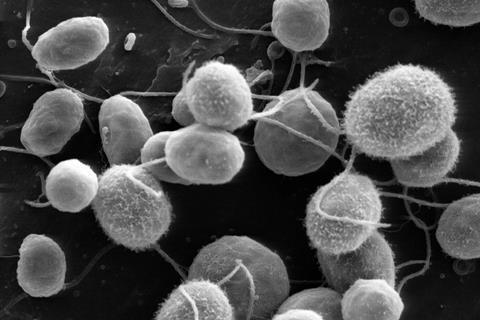A new method that research teams can use to measure and compare different forms of proteins and protein complexes helped reveal a previously unseen molecular signature of how algal genomes are controlled during the cell cycle.

The publication, “pyMS-Vis, an open-source Python application for visualizing and investigating deconvoluted to-down mass spectrometric experiments: A histone proteoform case study” was recently published in the journal, Analytical Chemistry (2024) doi:10.1021/acs.analchem.4c02650.
READ MORE: Study illuminates cues algae use to ‘listen’ to their environment
READ MORE: Researchers discover genetic collaboration in harmful algae
The research collaboration included James Umen, PhD, member and principal investigator, Danforth Plant Science Center, James (Jim) Pesavento, PhD, associate professor at Saint Mary’s College of California (SMC), Mowei Zhou, PhD, Qiushi scholar for experiments, Zhejiang University and Ljiljana Paša-Tolić, PhD, lead scientist for Visual Proteomics, Department of Energy Environmental and Molecular Sciences Laboratory in Richland, WA.
Algal cells
The Umen lab is well known for longstanding research to understand how algal cells multiply and differentiate into sexually distinct types. Pesavento is an expert in using mass spectrometry to identify biological molecules with extremely high precision and to quantify their abundance. His special expertise is on a very important group of proteins called histones that are used to package DNA in all organisms whose cells have a nucleus including plants, algae and humans.
Histones are not only essential for packaging and DNA into a compact form called chromatin, but also are decorated with chemical modifications that serve as signals or signposts marking locations of genes and whether they should be expressed. These markings are sometimes referred to as an epigenome as they add an additional layer of information to the DNA with which they associate.
A major challenge in this field has been figuring out which histones have which chemical modifications, where on the histone protein those modifications occur, and whether they are dynamic (added and removed under specific conditions). The combinatorial possibilities make this task especially difficult even with the most advanced mass spectrometry instrumentation and software available. Moreover, each group of organisms such as plants and green algae, seem to have their own variant histone code language, and it is important to learn this language as a tool for helping make improved varieties with beneficial traits.
Time-consuming tasks
Although commercial software exists to help with this task, there was no software that was robust enough to tackle histone modifications on whole histone proteins. Pesavento realized that the repetitive and time-consuming tasks to identify histone modifications could be partially automated, and he set out to create an open-source tool called pyMS-Vis to help solve this problem for algal histones and other histone researchers.
“This work started as a collaboration with SMC professor Udayan Das, PhD, as we co-mentored an undergraduate computer science student Megan Bindra during the SMC undergraduate Summer Research Program in 2022,” said Pesavento. “We were able to make significant progress, and Bindra presented this work at a professional conference the following year (2023). The combination of NSF funding support for my small lab at SMC and invested collaborators across diverse scientific disciplines, were essential to this work’s publication.”
To test this method, he used a set of histone samples the Umen lab prepared from cells that were in different stages of their cell division cycle to answer questions about what happens to marks on histones in cells when they are replicating their DNA versus when they are growing but not replicating DNA or dividing. pyMS-Vis made it possible to rapidly analyze the data and discover a new and unexpectedly large population of a specific histone sub-type that was missing a mark which had always been assumed to be present on nearly every histone of this sub-type.
“pyMS-Vis has allowed us to see histone dynamics that we could not easily see before and opened the door to a more complete understanding of the language of algal gene expression,” said Umen. “This deeper understanding will be a critical part of developing algae as productive crop species that stably express beneficial traits such as increased yields of oil or high value products.”







No comments yet